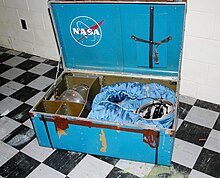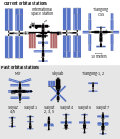Manned Orbiting Laboratory: Difference between revisions
Leon103102 (talk | contribs) No edit summary Tags: Mobile edit Mobile web edit |
Rescuing 2 sources and tagging 0 as dead. #IABot (v1.4beta) |
||
| Line 39: | Line 39: | ||
The [[Astronaut propulsion unit#USAF Astronaut Maneuvering Unit|USAF Astronaut Maneuvering Unit]] (AMU) was developed for the MOL project. NASA chief astronaut [[Deke Slayton]] later speculated in his autobiography that the AMU may have been developed for MOL because the Air Force "thought they might have the chance to inspect somebody else's satellites."{{sfn|Slayton|Cassutt|1994|p=174}} |
The [[Astronaut propulsion unit#USAF Astronaut Maneuvering Unit|USAF Astronaut Maneuvering Unit]] (AMU) was developed for the MOL project. NASA chief astronaut [[Deke Slayton]] later speculated in his autobiography that the AMU may have been developed for MOL because the Air Force "thought they might have the chance to inspect somebody else's satellites."{{sfn|Slayton|Cassutt|1994|p=174}} |
||
In response to the announcement of the MOL, the [[Soviet Union]] commissioned the development of its own military space station, [[Almaz]]. Three [[Almaz]] space stations flew as [[Salyut]] space stations, and the program also developed a military add-on used on [[Salyut 6]] and [[Salyut 7]].<ref>{{cite web |
In response to the announcement of the MOL, the [[Soviet Union]] commissioned the development of its own military space station, [[Almaz]]. Three [[Almaz]] space stations flew as [[Salyut]] space stations, and the program also developed a military add-on used on [[Salyut 6]] and [[Salyut 7]].<ref>{{cite web|url=http://www.russianspaceweb.com/almaz.html |title=The Almaz program |work=Russian Space Web |accessdate=12 February 2011 |deadurl=yes |archiveurl=https://web.archive.org/web/20110514000112/http://www.russianspaceweb.com/almaz.html |archivedate=14 May 2011 |df= }}</ref><ref>{{cite web|url=http://www.astronautix.com/project/almaz.htm |title=Almaz |work=Encyclopedia Astronautica |first=Mark |last=Wade |accessdate=12 February 2011 |deadurl=yes |archiveurl=https://web.archive.org/web/20101119184429/http://astronautix.com/project/almaz.htm |archivedate=19 November 2010 |df= }}</ref><ref>{{cite web |url=http://www.svengrahn.pp.se/histind/Almprog/almprog.htm |title=The Almaz Space Station Program |work=Sven's Space Place |first=Sven |last=Grahn |accessdate=12 February 2011}}</ref> |
||
===Specifications=== |
===Specifications=== |
||
Revision as of 02:30, 1 June 2017
 A 1967 conceptual drawing of the Gemini B reentry capsule separating from the MOL at the end of a mission | |
| Station statistics | |
|---|---|
| Crew | 2 |
| Launch pad | Vandenberg SLC-6 |
| Mission status | Cancelled |
| Mass | 14,476 kg (31,914 lb) |
| Length | 21.92 m (71.9 ft) |
| Diameter | 3.05 m (10.0 ft) |
| Pressurised volume | 11.3 m3 (399.1 cu ft) |
| Orbital inclination | polar or sun synchronous orbit |
| Days in orbit | 40 days |
| Configuration | |
 Configuration of the Manned Orbital Laboratory | |
The Manned Orbiting Laboratory (MOL), originally referred to as the Manned Orbital Laboratory, was part of the United States Air Force's manned spaceflight program, a successor to the cancelled Boeing X-20 Dyna-Soar military reconnaissance space plane project. The project was developed from several early Air Force and NASA concepts of manned space stations to be used for reconnaissance purposes. MOL evolved into a single-use laboratory, with which crews would be launched on 40-day missions and return to Earth using a Gemini B spacecraft, derived from NASA's Project Gemini.
The MOL program was announced to the public on 10 December 1963 as a manned platform to prove the utility of man in space for military missions.[1] Astronauts selected for the program were later told of the reconnaissance mission for the program.[2] The contractor for the MOL was the Douglas Aircraft Company. The Gemini B was externally similar to NASA's Gemini spacecraft, although it underwent several modifications, including the addition of a circular hatch through the heat shield, which allowed passage between the spacecraft and the laboratory.[3]
MOL was cancelled in 1969, during the height of the Apollo program, when it was shown that unmanned reconnaissance satellites could achieve the same objectives much more cost-effectively. U.S. space station development was instead pursued with the civilian NASA Skylab (Apollo Applications Program) which flew in the mid-1970s.
In the 1970s, the Soviet Union launched three Almaz military space stations, similar in intent to the MOL, but cancelled the program in 1977 for the same reasons.
Planned operations
The MOL was planned to use a helium-oxygen atmosphere. It used a Gemini B spacecraft as a reentry vehicle.
The crew were to be launched using a Titan 3M with the stacked Gemini B and MOL, and returned to Earth in the Gemini B. They would conduct up to 40 days of military reconnaissance using large optics, cameras, and side-looking radar.
The USAF Astronaut Maneuvering Unit (AMU) was developed for the MOL project. NASA chief astronaut Deke Slayton later speculated in his autobiography that the AMU may have been developed for MOL because the Air Force "thought they might have the chance to inspect somebody else's satellites."[4]
In response to the announcement of the MOL, the Soviet Union commissioned the development of its own military space station, Almaz. Three Almaz space stations flew as Salyut space stations, and the program also developed a military add-on used on Salyut 6 and Salyut 7.[5][6][7]
Specifications
- Crew: 2
- Maximum duration: 40 days
- Orbit: Sun synchronous or polar
- Length: 21.92 m (71.9 ft)
- Diameter: 3.05 m (10.0 ft)
- Habitable volume: 11.3 m3 (400 cu ft)
- Gross mass: 14,476 kg (31,914 lb)
- Payload: 2,700 kg (6,000 lb)
- Power: fuel cells or solar cells
- RCS system: N2O4/MMH
- Reference: [8]
Gallery
-
MOL main features
-
Early 1960s MOL conceptual drawing that did not use the Gemini spacecraft
-
Integral launch dual compartment laboratory
-
MOL variations
-
MOL spacesuit
-
Astronaut Maneuvering Unit (AMU), developed for MOL
Gemini B
The Gemini capsule was redesigned for MOL and named Gemini B. Externally it was similar to Gemini, but featured a rear hatch for the crew to enter MOL and many specific systems.
Gemini B would be launched with the MOL space station. Once in orbit, the crew would power down the capsule and activate MOL. After about one month of space station operations, the crew would return to the Gemini B capsule, separate from the station and perform reentry. Gemini B had an autonomy of about 14 hours once detached from MOL.[9]
Changes from Gemini
- Systems designed for long term orbital storage (40 days)
- New cockpit layout and instruments[10]
- Helium-oxygen cabin atmosphere
- Larger heat shield to handle higher energy reentries from polar orbit
- Spacecraft orientation was handled by the forward RCS thrusters only (no Gemini OAMS)
- Six solid propellant retrofire motors, used for deorbit or abort rockets in case of launch vehicle failure
Reentry module specifications
Gallery
-
Mockup of the Gemini B capsule intended for the MOL program
-
Gemini B prototype spacecraft (Gemini 2) used on only MOL test, on display at the Air Force Space & Missile Museum
-
Heat Shield with Hatch
-
Display Panel
-
Gemini B Nose
-
Gemini-B layout
Astronauts

Top row L-R: Herres, Hartsfield, Overmyer, Fullerton, Crippen, Peterson, Bobko, Abrahamson.
Bottom Row L-R: Finley, Lawyer, Taylor, Crews, Neubeck, Truly.
- MOL Group 1 - November 1965
- Michael J. Adams USAF (1930-1967) — killed on X-15 flight, 15 November 1967
- Albert H. Crews Jr. USAF
- John L. Finley USN (1935-2006)
- Richard E. Lawyer USAF (1932-2005)
- Lachlan Macleay USAF
- Francis G. Neubeck USAF
- James M. Taylor USAF (1930-1970) — killed on T-38 flight, 4 September 1970
- Richard H. Truly USN — Pilot, Space Shuttle Enterprise ALT #2, STS-2; Commander: STS-8; Commander, Naval Space Command as a Vice Admiral; Administrator: NASA, 1989–92
- MOL Group 2 - June 1966
- Karol J. Bobko USAF — Pilot, STS-6, Commander, STS-51-D, STS-51-J
- Robert L. Crippen USN — Pilot, STS-1, Commander, STS-7, STS-41-C, STS-41-G; Director, Kennedy Space Center, 1992–95
- C. Gordon Fullerton USAF (1936-2013) — Pilot, Space Shuttle Enterprise ALT #1, STS-3, Commander, STS-51-F
- Henry W. Hartsfield, Jr. USAF (1933-2014) — Pilot, STS-4, Commander, STS-41-D, STS-61-A; Director, Human Exploration and Development of Space Independent Assurance
- Robert F. Overmyer USMC (1936-1996) — Pilot, STS-5, Commander: STS-51-B; killed in Cirrus crash, 22 March 1996
- MOL Group 3 - June 1967
- James A. Abrahamson USAF — Director: Strategic Defense Initiative as a Lieutenant General
- Robert T. Herres USAF (1932-2008) — Vice Chairman: Joint Chiefs of Staff as a General
- Robert H. Lawrence, Jr. USAF (1935-1967) — Killed in training accident, 8 December 1967
- Donald H. Peterson USAF — Mission specialist: STS-6
Flight schedule
Completed
Proposed
- 1970 December 1 - MOL 1 - First unmanned Gemini-B/Titan IIIM qualification flight (Gemini-B flown alone, without an active MOL)
- 1971 June 1 - MOL 2 - Second unmanned Gemini-B/Titan 3M qualification flight (Gemini-B flown alone, without an active MOL)
- 1972 February 1 - MOL 3 - A crew of two (James M. Taylor, Albert H. Crews) would have spent thirty days in orbit
- 1972 November 1 - MOL 4 - Second manned mission
- 1973 August 1 - MOL 5 - Third manned mission
- 1974 May 1 - MOL 6 - Fourth manned MOL mission. All Navy crew composed of Richard H. Truly and Robert Crippen
- 1975 February 1 - MOL 7 - Fifth manned MOL
Operational MOLs were to be launched on Titan IIIM rockets from Vandenberg AFB SLC-6 and Cape Canaveral AFS LC-40.[citation needed]
Development
Test Flight

Test flight OPS 0855 for MOL was launched on 3 November 1966 at 13:50:42 UTC on a Titan IIIC-9 from Cape Canaveral Launch Complex 40. The flight consisted of a MOL mockup built from a Titan II propellant tank, and the refurbished Gemini 2 spacecraft as a Gemini B prototype.
After the Gemini B separated for a sub-orbital reentry, the MOL mockup continued into orbit and released three satellites. A hatch installed in the Gemini's heat shield—intended to provide access to the MOL during manned operations—was tested during the capsule's reentry. The Gemini capsule was recovered near Ascension Island in the South Atlantic by the USS La Salle after a flight of 33 minutes.
The Gemini 2 capsule used in the only flight of the MOL program is on display at the Air Force Space & Missile Museum at Cape Canaveral Air Force Station.[12] A test article at the National Museum of the United States Air Force, Wright-Patterson AFB, Ohio, is the Gemini B spacecraft (sometimes confused with Blue Gemini). It is recognized by its distinctive "US Air Force" written on the side, and the circular hatch cut through the heat shield.[13]
KH-10

Starting in 1965 a large optical system was added to the spacecraft for military reconnaissance. This camera system was codenamed Dorian and given the designation KH-10. The project was canceled on 10 June 1969 before any operational flights occurred.
The KH-10 intended for the MOL program was succeeded by the unmanned KH-11 Kennan, which launched in 1976 as the Soviet Union was winding down its manned space reconnaissance program. The KH-11 is said to have achieved the goal of 3-inch (76 mm) imaging resolution and introduced video transmission of images back to Earth.[2]
Cancellation
The program was canceled on 10 June 1969 with the first projected flight three years away. Between 1965 and 1969, MOL's projected cost rose from $1.5 billion to $3 billion while the Vietnam War took larger portions of the defense budget. While Defense Secretary Melvin R. Laird and the Joint Chiefs of Staff strongly supported the station, Central Intelligence Agency head Richard Helms did not support the project because he feared that the death of a MOL astronaut might ground launches and thus damage the nation's satellite reconnaissance program. President Richard Nixon and National Security Advisor Henry Kissinger agreed to the Bureau of the Budget's proposal to cancel MOL,[14] as it was determined the capabilities of unmanned spy satellites met or exceeded the capabilities of manned MOL missions.
NASA offered those under 35 years of age the opportunity to transfer to its astronaut program. Seven of the 14 MOL astronauts were younger than 35 and took the offer, becoming NASA Astronaut Group 7: future NASA Administrator Richard H. Truly, Karol J. Bobko, Robert Crippen, C. Gordon Fullerton, Henry W. Hartsfield, Robert F. Overmyer, and Donald H. Peterson. All flew on the Space Shuttle.
Declassification

In 2005, two MH-7 training space suits from the MOL program were discovered in a locked room in the Launch Complex 5/6 museum on Cape Canaveral.[15] In July 2015, the National Reconnaissance Office declassified over 800 files and photos related to the Manned Orbiting Laboratory program.[16]
In fiction
In the 2016 novel Blue Darker Than Black by Mike Jenne, the MOL program is secretly transferred from the Air Force to the United States Navy after its official cancellation in 1969. The Navy launches an ocean surveillance MOL in July 1972. Two Air Force Blue Gemini astronauts fly a rescue mission to the MOL after its crew is incapacitated by the August 4, 1972 solar storm.[17]
See also
- Manned Orbital Development System
- Polyus - Soviet orbital weapons platform
References
- ^ "Air Force to Develop Manned Orbiting Laboratory" (PDF) (Press release). Department of Defence. 10 December 1963.
- ^ a b "NOVA: Astrospies". PBS. Retrieved 13 October 2011.
- ^ Slayton & Cassutt 1994, p. 249.
- ^ Slayton & Cassutt 1994, p. 174.
- ^ "The Almaz program". Russian Space Web. Archived from the original on 14 May 2011. Retrieved 12 February 2011.
{{cite web}}: Unknown parameter|deadurl=ignored (|url-status=suggested) (help) - ^ Wade, Mark. "Almaz". Encyclopedia Astronautica. Archived from the original on 19 November 2010. Retrieved 12 February 2011.
{{cite web}}: Unknown parameter|deadurl=ignored (|url-status=suggested) (help) - ^ Grahn, Sven. "The Almaz Space Station Program". Sven's Space Place. Retrieved 12 February 2011.
- ^ "MOL". Astronautix.com.
- ^ http://space.skyrocket.de/doc_sdat/gemini-b.htm
- ^ http://www.space1.com/pdf/news1096.pdf
- ^ "Gemini B RM". Astronautix.com.
- ^ "Gemini Capsule". Air Force Space & Missile Museum. Retrieved 17 June 2014.
- ^ "Gemini Spacecraft". National Museum of the US Air Force. 7 March 2007. Retrieved 12 February 2011.
- ^ Heppenheimer, T. A. (1998). The Space Shuttle Decision. NASA. pp. 204–205. OCLC 40305626. SP-4221.
- ^ Nutter, Ashley (2 June 2005). "Suits for Space Spies". NASA.gov. Retrieved 12 February 2011.
- ^ "Index, Declassified Manned Orbiting Laboratory (MOL) Records". National Reconnaissance Office. Retrieved 3 November 2015.
- ^ Jenne, Mike (2016). Blue Darker Than Black. Yucca Publishing. ISBN 978-1-63158-066-6.
Bibliography
- Slayton, Donald K. "Deke"; Cassutt, Michael (1994). Deke! U.S. Manned Space: From Mercury to the Shuttle (1st ed.). New York: Forge. p. 249. ISBN 0-312-85503-6. LCCN 94002463. OCLC 29845663.
{{cite book}}: Invalid|ref=harv(help)
External links
- MOL at Encyclopedia Astronautica
- Declassified MOL files by the National Reconnaissance Office
- SSLV-5 No. 9 Post Firing Flight Test Report (Final Evaluation Report) and MOL-EFT Final Flight Test Report (Summary)
- Winfrey, David (16 November 2015). "The last spacemen: MOL and what might have been". The Space Review.















